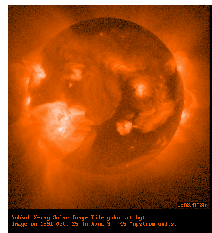
Unknown spectral lines emitted by the corona were similarly credited to a new element “coronium” until Edlen showed that they came from the familiar atoms of iron, nickel and calcium, after they had lost an appreciable number of electrons (e.g. 13 or 14 for iron). Such high levels of ionization require the atoms to be buffeted around by extremely high temperatures, around 1,000,000 C (1,800,000 F).
The source of the corona’s heat remains a puzzle. It is almost certain that its energy comes from the Sun’s internal furnace, which also supplies the rest of the Sun’s heat. However, as a rule, temperatures are expected to drop the further one gets from the furnace, whereas the million-degree corona lies outside the surface layer where sunlight originates, whose temperature is less that 6000 C.
The Corona in X-ray Light
All hot objects emit electromagnetic waves–for example, visible light is emitted by the hot filament inside a lightbulb. The hotter the object, the shorter the wavelength, which is why the corona emits “soft x rays,” whose waves are much shorter than those of visible or ultra-violet light.
 |
| Click HERE for a full size version of this image |
The corona has been observed in these wavelengths by, among others, the space station Skylab in 1973-4 and more recently by the Japanese spacecraft Yohkoh, which provided the picture shown below. The corona in such pictures appears quite uneven. It is brightest near sunspots, whose arched field lines apparently hamper the outflow of solar wind which carries away energy and helps cool the corona. It is darker in “coronal holes” in between, where field lines apparently extend out to distant space, making it easier for the solar wind to escape.





























